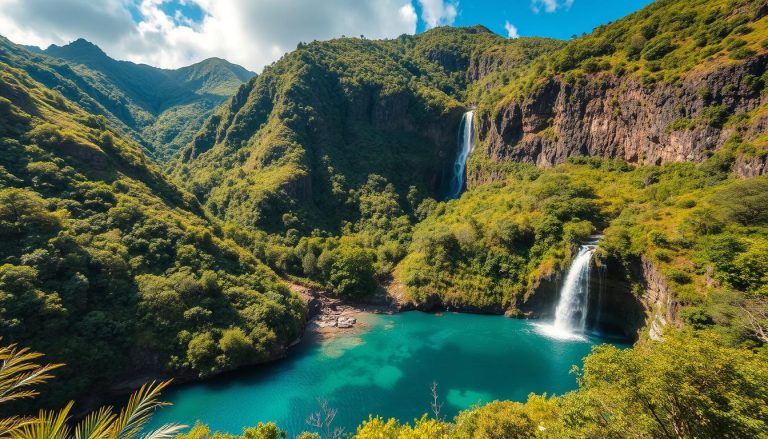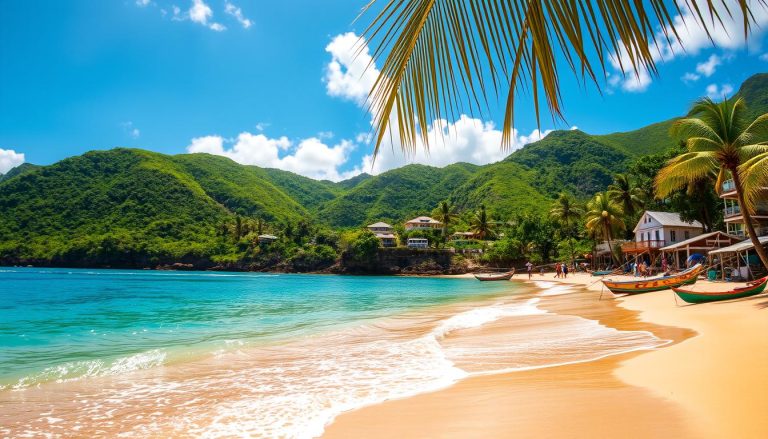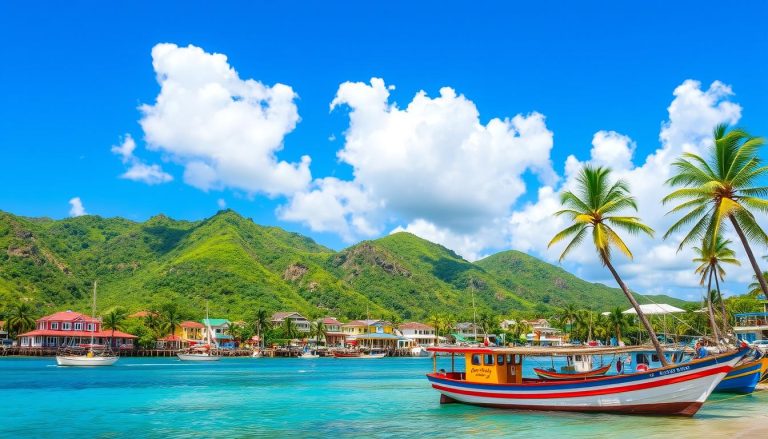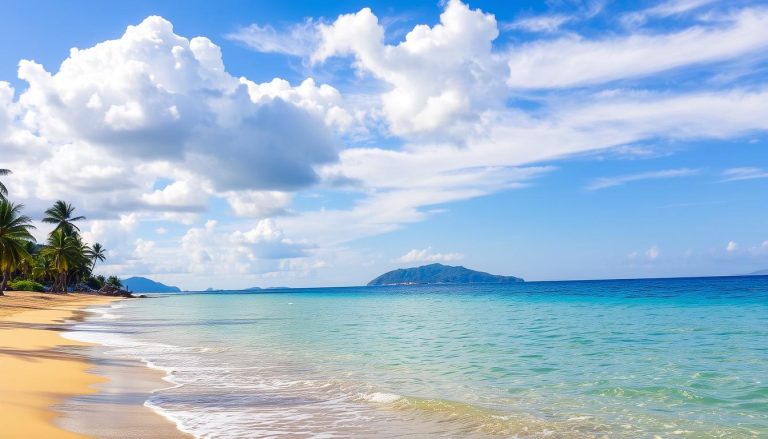Are you thinking about visiting a less-traveled tropical paradise? Dominica, known as the “Nature Island” in the Caribbean, offers beautiful views. It has lush greenery, waterfalls, and unique animals. But when should you go to enjoy its weather and nature most?
Dominica stands out as a mountainous island in the Caribbean. It is popular for its unique travel experiences, weather, and climate. It has many natural parks, making it perfect for adventurers who love exploring wildlife. The island has a warm, humid weather all year. This makes it great for a memorable vacation.
Key Takeaways
- Dominica experiences a distinct dry season from December to April, perfect for outdoor activities.
- The wetter season from June to October brings an increased risk of hurricanes but has cheaper accommodation.
- The shoulder season of May, June, and November offers moderate rainfall and fewer crowds.
- Packing lightweight, breathable clothing and rain gear is essential for any Dominica trip.
- Exploring Dominica’s natural wonders, such as Morne Trois Pitons National Park and Champagne Reef, is a must.
Dominica's Climate and Weather Patterns
Dominica, known as the jewel of the Caribbean, enjoys a maritime tropical climate. This means it’s warm and humid all year. Knowing about Dominica’s weather patterns can enhance your Dominica vacation planning.
Maritime Tropical Climate
Dominica has a mean temperature around 26°C. It gets cooler from December to February, dropping to 24-25°C. Along the coasts, temperatures can hit 33°C, but it stays cooler in the mountains, around 27°C. This mix offers diverse experiences in the Dominica climate.
Dry and Wet Seasons
From December to April, Dominica has a dry season with less rain. The wet season is from June to October, with much more rain. Monthly, you can expect 250-400mm during these wet months. This season also sees a higher chance of tropical storms and hurricanes.
Temperature Ranges
Around Dominica, you’ll find temperatures between 74-89°F (23-32°C) all year. The drier months have the highest temperatures. But, the wet season brings cooler weather. This gives you a mix of warm and comfortable conditions to enjoy Dominica’s Dominica weather.
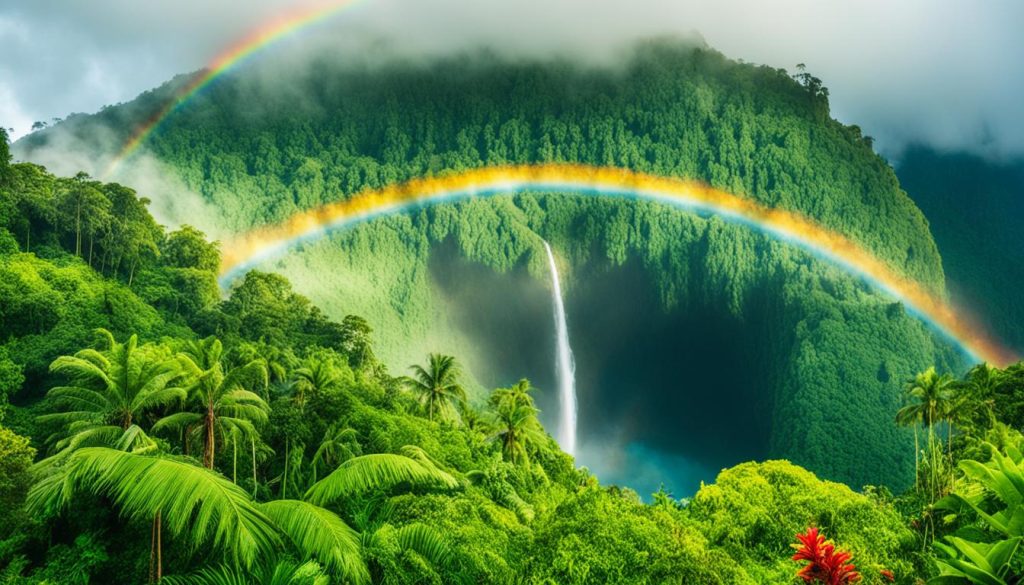
Peak Season: December to April
In Dominica, the peak tourist season goes from December to April. This time is favorite because of the sunny weather. It’s great for outdoor activities since the island gets little rain.
Dominica has amazing hiking trails, waterfalls, and beaches. They are even more beautiful under the sun. It’s perfect for enjoying the island’s lush rainforests and volcanic landscapes.
Because of the great weather and lots of visitors, places to stay and travel costs more. It’s smart to book early for the best prices.
Shoulder Season: May to June and November
The shoulder season in Dominica lasts from May through June and November. During these months, there’s more rain than in the dry season. Despite the rain, the weather remains warm, perfect for exploring.
Since fewer people visit, you’ll find accommodations and travel expenses lower. This makes it a great time to visit the island. Not only will you save money, but you’ll also avoid the crowds.
| Month | Rainfall | Tourist Levels | Accommodation Costs |
|---|---|---|---|
| May | Moderate | Fewer | More Affordable |
| June | Moderate | Fewer | More Affordable |
| November | Moderate | Fewer | More Affordable |
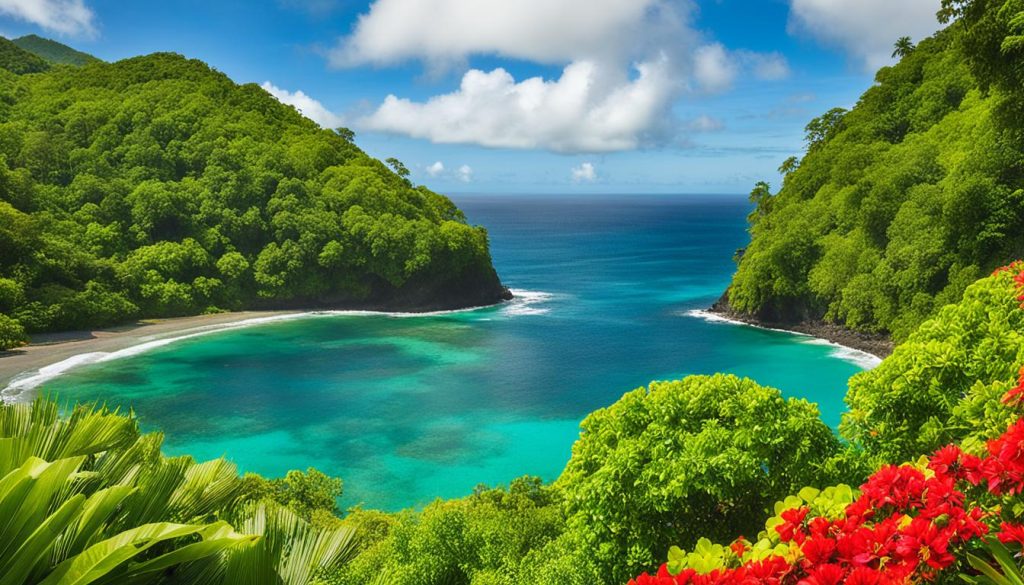
Low Season: July to October
Dominica’s low season spans July to October, aligning with the Atlantic hurricane season from June 1st to November 30th. The island faces a higher risk of tropical storms and hurricanes. Yet, being directly hit is not common. This season is great for adventurous Dominica travel lovers.
Discounted Accommodations
In the low season, Dominica’s hotels and resorts slash prices. This aims to draw in more visitors. If you’re okay with some wet weather, you can enjoy big savings. It’s a chance to see Dominica’s beauty at a cheaper cost.
Surfing Opportunities
During the low season, more rain and storms mean better waves for surfing on Dominica’s northeast coast. For those who love a good surf, this is a perfect time to visit. You can enjoy exciting wave action. It makes for a memorable Dominica vacation.
Dominica: Best Months for a Weather-Savvy Trip
For those wanting great weather, the best time to visit Dominica is from December to April. This period is dry and sunny, making it perfect for outdoor fun and exploring. For those looking for lesser-known times, May, June, and November have less rain and fewer tourists.
The low season from July to October means more rain and hurricane risks, but there are good deals on places to stay. It’s also the best time for surfing. No matter when you go, Dominica’s tropical weather and beautiful nature promise an amazing trip.

Essential Packing Tips
When getting ready for your trip to Dominica
, packing smart is key. Make sure you bring the right stuff to keep comfortable and ready for everything during your
. Lightweight, breathable clothes are perfect for the island’s
Lightweight and Breathable Clothing
Look for clothes that dry fast and let air flow through, like cotton and linen. Stay away from heavy, fake fibers that make you sweat in the heat. Choose loose, airy clothes for a comfortable fit and to stay on top of the weather-savvy look during your hikes.
Rain Gear and Waterproof Accessories
No matter what the Dominica weather is like, be ready for rain with a light rain jackets or ponchos. Don’t forget waterproof bags and phone cases to keep your stuff dry during sudden rain showers, which happen a lot, even in the dry months.
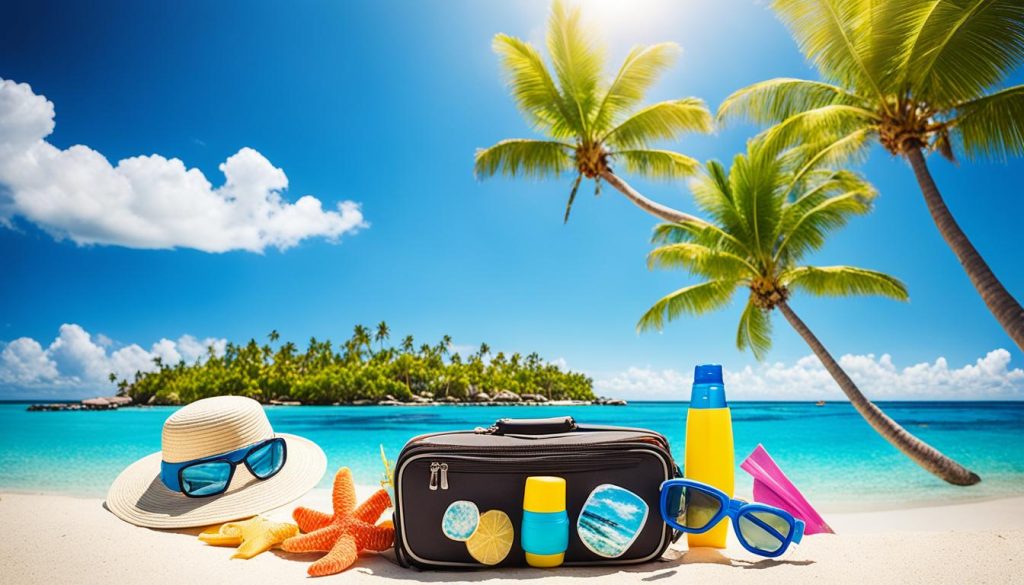
Festivals and Events in Dominica
Dominica is known for its vibrant culture. It celebrates with many annual festivals and events. These draw in both the locals and visitors. You’ll hear carnival’s rhythmic beats and the emotional Creole music, truly showing the island’s spirit.
Carnival
The annual Carnival festival in Dominica happens from February to March. It’s a must-see Dominica travel experience. Here, you’ll enjoy lively calypso music, energetic contests, and colorful parades. The excitement peaks in two days of celebration, with everyone donning bright costumes and dancing in the streets.
World Creole Music Festival
The World Creole Music Festival marks the end of October. It’s a gem for celebrating Dominica’s music. You can enjoy a mix of Creole music types like cadence-lypso, Kompa, and zouk. This event offers a full Dominica experience.
| Festival | Date | Highlights |
|---|---|---|
| Carnival | February or March | Calypso music, competitions, vibrant street parades |
| World Creole Music Festival | Late October | Celebration of Creole music genres, including cadence-lypso, Kompa, zouk, and zydeco |
Getting Around Dominica
Traveling around Dominica is easy with many transportation options for Dominica travelers. Whether you like rented cars or choosing public buses, there’s something for everyone’s Dominica travel adventure.
Rental Cars and Taxis
Exploring Dominica’s natural beauty is best by renting a four-wheel-drive vehicle. The island’s roads are rough and twisty, so a tough, high-clearance car is perfect. There are taxis too, especially in Roseau and at the airports, making Dominica vacation planning simple.
Public Transportation
If you’re looking to save money, the public bus system is great. Buses with an “H” on their plates run between Roseau and other spots, like the Roseau Valley. This is an Dominica climate-friendly way to enjoy the island’s beauty at your own pace.
Top Attractions and Activities
When you visit Dominica, you step into a world rich with nature. There’s plenty to do for people who love the outdoors. You can hike through volcanic lands, see beautiful waterfalls, and explore the sea.
Hiking in Morne Trois Pitons National Park
The Morne Trois Pitons National Park is a special place on this island. It’s a UNESCO site full of hiking trails. You’ll find amazing spots like the Boiling Lake, a hot lake that shows how the land has changed over time.
Exploring Waterfalls and Gorges
Dominica has more than the Boiling Lake to see. There are stunning waterfalls and gorges. The Trafalgar Falls and Titou Gorge are perfect for swimming and getting close to nature.
Snorkeling and Diving at Champagne Reef
Under the sea’s surface, Champagne Reef awaits. It’s known for the bubbles that float up from the sea bottom. Here, you can snorkel or dive and see coral, fish, and more. It’s a unique and fascinating experience.
Regions and Highlights
Roseau, the capital city of Dominica, is lively and full of history. It has narrow streets with old stone-and-wood buildings. Just to the east of Roseau is the Roseau Valley. This area is known for its top natural spots like the Trafalgar Falls and the sulphur hot springs at Wotten Waven.
Roseau and the Roseau Valley
Roseau is the vibrant heart of Dominica, mixing old colonial style with the local vibe. It has a bustling market, a grand Roman Catholic Cathedral, and quiet Botanical Gardens. A short drive away leads to the Roseau Valley’s incredible natural scenery.
At the Roseau Valley, see the amazing Trafalgar Falls. These waterfalls drop 65 meters in a dense green forest. Further to the east, you’ll find Wotten Waven. Here, you can relax in warm, geothermal sulphur springs, surrounded by beautiful nature.
Conclusion
Dominica is unlike any other Caribbean spot. It’s a haven for those who love nature. Here, you’ll find a vibrant, volcanic land filled with natural treasures. You should learn about the island’s weather to plan your trip well. This way, you can enjoy outdoor fun, join festivals, and dive into the local culture when the time is right.
No matter when you go – whether it’s busy, sort of busy, or quiet – you can shape your journey just as you like. This ensures a memorable stay on the “Nature Island” of the Caribbean. From the lively Roseau to the breathtaking natural scenes across the island, Dominica truly shows off the Caribbean’s charm and variety.
So, don’t wait any longer. Start mapping out your adventure in Dominica today. Get ready for a place of natural beauty, rich culture, and lasting memories. The “Nature Island” is eager to welcome you and show you its very best.

